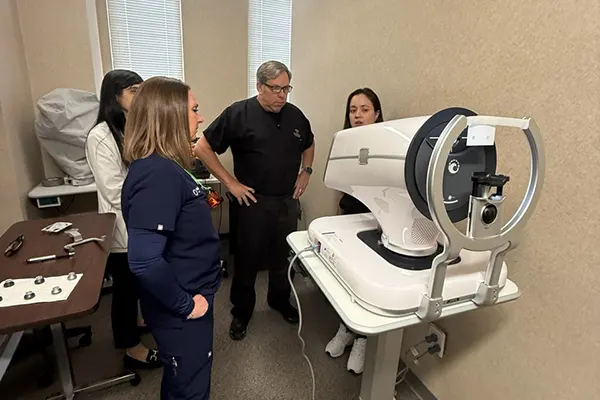Diabetic Retinopathy
How Does Diabetic Retinopathy Damage the Retina?
Most foods are digested, and broken down into useful nutrients which the body depends upon to grow, function, and fight disease. One of the most important byproducts of this process is sugar, which is essential for the normal function of many organ systems, including the brain. As with other nutrients, too much sugar can be quite harmful to the body’s delicate tissues. Diabetes is caused by the body’s inability to regulate circulating blood sugar, usually due to its difficulty in producing enough insulin in the pancreas to keep sugar levels within the normal range.
Diabetes, whether insulin-dependent or treated with diet or oral medications (non-insulin-dependent), damages blood vessels throughout the body. This is why people with diabetes may develop multi-organ disease, including damage to the kidneys (nephropathy), nerves, causing disease in the extremities (neuropathy), and the retina of the eye (retinopathy). It also makes patients particularly susceptible to heart disease and stroke.
Because diabetes damages the blood vessels, the circulating blood may leak out into the tissue, in this case, the retina or vitreous cavity in the back of the eye, causing hemorrhage, swelling, and ultimately scarring. As the disease progresses, the body tries to grow new blood vessels in order to supply much-needed blood carrying nutrition and oxygen to the damaged retina. These new vessels are particularly diseased and leak even more so than original vessels. As a result, the retina loses its ability to function, due both to a lack of nutrients and oxygen, and ultimately, from the scarring which results.
Diabetic retinopathy may be treated at certain stages with a laser, which helps seal off the leaking blood vessels. While this laser treatment does not prevent future disease from occurring, it can be quite successful in slowing it down. The laser treatment takes only minutes and is usually very well tolerated by the patient, simply numbing the eye with anesthetic drops beforehand.
Ideally, the best chance for treating diabetes is early detection of those people at risk, and prevention, which comes from careful attention to diet and lifestyle (exercise).
In the future, much hope is placed in treatments including gene therapy and pancreatic islet cell transplants, which may allow a diabetic patient to produce enough insulin naturally, to avoid the need for medications, and avoid the damaging effects of the disease.
Who is at Risk for this Disease?
People who are overweight, or who get little or no exercise are primarily at risk. In addition, African Americans, those with a family history of diabetes, and women during pregnancy are also vulnerable to developing diabetes. If diabetes occurs during childhood, it is classified as Type 1, or juvenile-onset diabetes. If diabetes occurs for the first time in adulthood, it is considered as Type 2, or adult-onset diabetes.
What Are the Symptoms of Diabetic Retinopathy?
Systemically, patients with diabetes will report unusual thirst and frequent urination, as well as fatigue. From an ocular standpoint, vision will commonly fluctuate with rising and falling blood sugar. Patients may notice times during the day when their vision is quite blurred. As the disease progresses and hemorrhaging or swelling develops, permanent visual loss may occur.
Spots of blood are often followed within a few days or weeks by a much greater leakage of blood. In extreme cases, a person will only be able to tell light from dark. It may take the blood months or even years to clear from the inside of the eye. In some cases, the blood will not clear, and may require surgical removal. You should be aware that large hemorrhages tend to happen more than once, often during sleep.


